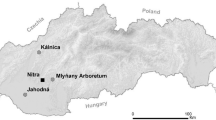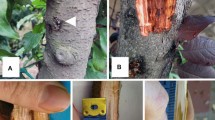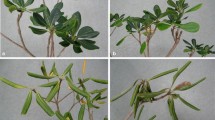Abstract
Yezo spruce trees (Picea jezoensis), approximately 40-year-old were inoculated with eight ophiostomatoid fungi associated withIps typographus f.japonicus to compare relative virulence of the fungi. Among them,Ophistoma penicillatum formed the longest necrotic lesion on inner bark around inoculation points, followed byO. aenigmaticum, Ceratocystis polonica, andO. bicolor, whileC. polonica formed a larger dry zone in sapwood than the other fungi. Yezo spruce trees were also mass inoculated withC. polonica, O. penicillatum, O. piceae singly or mixed to demonstrate the ability of the fungi to kill Yezo spruce trees. The trees inoculated withC. polonica, O. penicillatum or the mixed inoculum showed discoloration of needles in the early summer of the next year and died by autumn. However, the trees inoculated withO. piceae or the control inocula did not die, except for one tree. These results indicated thatC. polonica andO. penicillatum were more virulent thanO. piceae and suggested that they might be at least partially responsible for the mortality of the beetle-infested Yezo spruce trees.
Similar content being viewed by others
Literature cited
Aoshima, K. (1965) Studies on wood-staining fungi of Japan. 345pp, Doctoral Thesis, University of Tokyo. (in Japanese with English summary)
Aoshima, K. and Hayashi, Y. (1956) A blue-stain fungus ofPicea jezoensis, Ophiostoma bicolor Davidson et Wells. Ann. Phytopathol. Soc. Jpn. 21: 43. (Abstract in Japanese)
Basham, H.G. (1970) Wilt of loblolly pine inoculated with blue-stain fungi of the genusCeratocystis. Phytopathology 60: 750–754.
Christiansen, E. (1985)Ceratocystis polonica inoculated in Norway spruce: Blue-staining in relation to inoculum density, resinosis and tree growth. Eur. J. For. Pathol. 15: 160–167.
Christiansen, E. and Bakke, A. (1988) The spruce bark beetle of Eurasia.In Dynamics of forest insect populations. Patterns, causes, implications. Berryman, A.A. (ed.), 603pp, Plenum Press, New York, 479–503.
Christiansen, E. and Solheim, H. (1990) The bark beetle-associated blue-stain fungusOphiostoma polonicum can kill various spruces and Douglas fir. Eur. J. For. Pathol. 20: 436–446.
Furniss, M.M., Solheim, H., and Christiansen, E. (1990) Transmission of blue-stain fungi byIps typographus (Coleoptera: Scolytidae) in Norway spruce. Ann. Entomol. Soc. Am. 83: 712–716.
Harding, S. (1989) The influence of mutualistic blue stain fungi on bark beetle population dynamics. Ph. D. thesis, Royal Veterinary and Agricultural University, Copenhagen.
Harrington, T.C. (1993) Diseases of conifers caused by species ofOphiostoma andLeptographium.In Ceratocystis andOphiostoma. taxonomy, ecology, and pathogenicity. Wingfield, M.J., Seifert, K.A., and Webber, J.F. (eds.), 293pp, The American Phytopathological Society Press, St. Paul, Minnesota, 161–172.
Horntvedt, R., Christiansen, E., Solheim, H., and Wang, S. (1983) Artificial inoculation withIps typographus-associated blue-stain fungi can kill healthy Norway spruce trees. Medd. Nor. Inst. Skogforsk. 38: 1–20.
Jacobs, K., Wingfield, M.J., Wingfield, B.D., and Yamaoka, Y. (1998) Comparison ofOphiostoma huntii andO. europhioides and description ofO. aenigmaticum sp. nov. Mycol. Res. 102: 289–294.
Käärik, A. (1975) Succession of microorganisms during wood decay.In Biological transformation of wood by microorganisms. Proceedings of the Sessions on Wood Products Pathology at the 2nd International Congress of Plant Pathology. September 10–12, 1973., Minneapolis, USA, Liese, W. (ed.), 203pp, Springer-Verlag, Berlin, 39–51.
Kaneko, S., Hasegawa, E., Yada, H., Sato, H., and Ichihara, A. (1993) Effect ofCeratocystis piceae and its metabolites on the seedlings of Japanese red pine. Trans. 104th Mtg. Jpn. For. Soc. 104: 613–614. (in Japanese)
Kirisits, T. (1998) Pathogenicity of three blue-stain fungi associated with the bark beetleIps typographus to Norway spruce in Austria. Österr. Z. Pilzk. 7: 191–201.
Kono, H. (1938) Relation of bark beetles and blue-stain fungi to death ofPicea jezoensis andP. glehnii. Hokkaido Ringyo Kaiho 36: 231–242. (in Japanese)
Kotynková-Sychrová, E. (1966) The mycoflora of bark-beetle galleries in Czechoslovakia. Ceská Mykol. 20: 45–53. (in Czech with English Summary)
Krokene, P. and Solheim, H. (1996) Fungal associates of five bark beetle species colonizing Norway spruce. Can. J. For. Res. 26: 2115–2122.
Krokene, P. and Solheim, H. (1998) Pathogenicity of four blue-stain fungi associated with aggressive and nonaggressive bark beetles. Phytopathology 88: 39–44.
Maeto, K., Ozaki, K., Hayashi, Y., and Koizumi, C. (1991) Wilt of Japanese larch inoculated withIps cembrae-associated blue-stain fungiCeratocystis piceae. Trans. 39th Ann. Mtg. Hokkaido Branch Jpn. For. Soc. 39: 79–82. (in Japanese with English summary)
Mathiesen, A. (1950) Über einige mit Borkenkäfern assoziierte Bläuepilze in Schweden. Oikos 2: 275–308.
Mathiesen, A. (1951) Einige neueOphiostoma-arten in Schweden. Sv. Bot. Tidskr. 45: 203–232.
Mathiesen-Käärik, A. (1953) Eine Übersicht über die gewöhnlichsten mit Borkenkäfern assoziierten Bläuepilze in Schweden. Medd. Statens Skogsforskningsinst. 43: 1–74.
Mathiesen-Käärik, A. (1960) Studies on the ecology, taxonomy and physiology of Swedish insect-associated blue stain fungi, especially the genusCeratocystis. Oikos 11: 1–25.
Mathre, D.E. (1964) Pathogenicity ofCeratocystis ips andCeratocystis minor toPinus ponderosa. Contrib. Boyce Thompson Inst. 22: 363–388.
Nelson, R.M. (1934) Effect of bluestain fungi on southern pines attacked by bark beetles. Phytopathol. Z. 7: 327–353.
Nevill, R.J. and Alexander, S.A. (1992) Pathogenicity of three fungal associates ofHylobius pales andPissodes nemorensis (Coleoptera: Curculionidae) to eastern white pine. Can. J. For. Res. 22: 1438–1440.
Numata, D. (1931) Blue-stain fungi, bark beetles, or dry? Hokkaido Ringyo Kaiho 29: 508–511. (in Japanese)
Paine, T.D., Raffa, K.F., and Harrington, T.C. (1997) Interactions among scolytid bark beetles, their associated fungi, and live host conifers. Annu. Rev. Entomol. 42: 179–206.
Peng, X., Kajimura, H., and Shibata, E. (1996) Response of Japanese red pine to inoculation with a blue stain fungus,Ceratocystis piceae. J. For. Res. 1: 41–44.
Rennerfelt, E. (1950) Über den Zusammenhang zwischen dem Verblauen des Holzes und den Insekten. Oikos 2: 120–137.
Safranyik, L., Shrimpton, D.M., and Whitney, H.S. (1983) The role of host-pest interaction in population dynamics ofDendroctonus rufipennis (Kirby) (Coleoptera: Scolytidae).In The role of insect-plant relationship in the population dynamics of forest pests. Proc. Int. Symp. Int. Union Forestry Res. Organ. (IUFRO)/UNESCO Program Man Biosphere (MAB). Isaev, A.S. (ed.), V.N. Sukacher Institute of Forest and Wood, Siberian Branch of the USSR Academy of Science, Krasnoyarsk, 197–212.
Siemaszko, W. (1939) Fungi associated with bark-beetles in Poland. Planta Pol. 7: 1–54. (in Polish with English Summary)
Solheim, H. (1986) Species of Ophiostomataceae isolated fromPicea abies infested by the bark beetleIps typographus. Nord. J. Bot. 6: 199–207.
Solheim, H. (1988) Pathogenicity of someIps typographus-associated blue-stain fungi to Norway spruce. Medd. Nor. Inst. Skogforsk. 40: 1–11.
Solheim, H. (1992a) The early stages of fungal invasion in Norway spruce infested by the bark beetleIps typographus. Can. J. Bot. 70: 1–5.
Solheim, H. (1992b) Fungal succession in sapwood of Norway spruce infested by the bark beetleIps typographus. Eur. J. For. Pathol. 22: 136–148.
Tochinai, Y. and Sakamoto, M. (1934) Studies on blue-stain of wood ofPicea jezoensis. Hokkaido Ringyo Kaiho 32: 334–342. (in Japanese)
Viiri, H. and Weissenberg, K. von (1995)Ophiostoma blue-staining fungi associated withIps typographus in Finland.In Forest pathology research in the Nordic countries 1994. Proceedings from the SNS-meeting in Forest Pathology at Skogbrukets Kurssenter, Biri, Norway 9–12 August 1994. Aamlid, D. (ed.), Aktuelt fra Skogforsk 4/95. Norsk institutt for skogforskning, Norway, 58–60.
Yamaguchi, T. (1995) Anatomical and water potential changes in Japanese larch inoculated withOphiostoma piceae.In Bark beetles, blue-stain fungi, and conifer defense systems. Christiansen, E. (ed.), 47pp, NISK, The Norwegian Forest Research Institute (NISK) in Ås, Norway, 24–25.
Yamaoka, Y. and Takahashi, I. (1995) Pathogenicity of ophiostomatoid fungi isolated from Yezo spruce infested byIps typographus f.japonicus to Yezo spruce seedlings. Abstr. 106th Mtg. Jpn. For. Soc. 106: 101. (Abstract in Japanese)
Yamaoka, Y., Hiratsuka, Y., and Maruyama, P.J. (1995) The ability ofOphiostoma clavigerum to kill mature lodgepole pine trees. Eur. J. For. Pathol. 25: 401–404.
Yamaoka, Y., Wingfield, M.J., Ohsawa, M., and Kuroda, Y. (1998) Ophiostomatoid fungi associated withIps cembrae in Japan and their pathogenicity to Japanese larch. Mycoscience 39: 367–378.
Yamaoka, Y., Wingfield, M.J., Takahashi, I., and Solheim, H. (1997) Ophiostomatoid fungi associated with the spruce bark beetleIps typographus f.japonicus in Japan. Mycol. Res. 101: 1215–1227.
Yoshida, N. (1994) Eightspined ips,Ips typographus japonicus Niijima.In Forest insects. Kobayashi, F. and Taketani, A. (eds.), 567pp. Yokendo Ltd., Tokyo, 171–178. (in Japanese)
Author information
Authors and Affiliations
Additional information
Part of this study was supported by the Sumitomo Foundation, Japan to Y. Yamaoka and I. Takahashi.
Contribution No. 143, Laboratories of Plant Pathology and Mycology, Institute of Agriculture and Forestry, University of Tsukuba.
About this article
Cite this article
Yamaoka, Y., Takahashi, I. & Iguchi, K. Virulence of ophiostomatoid fungi associated with the spruce bark beetleIps typographus f.japonicus in Yezo spruce. J For Res 5, 87–94 (2000). https://doi.org/10.1007/BF02762525
Accepted:
Issue Date:
DOI: https://doi.org/10.1007/BF02762525




